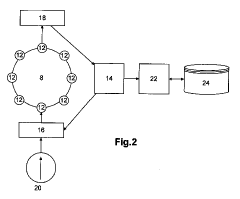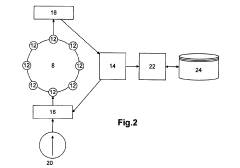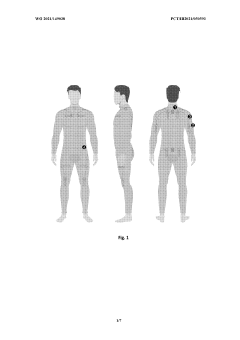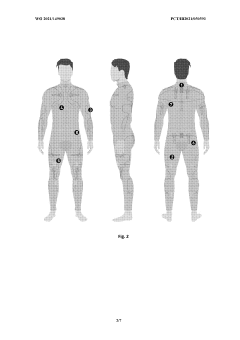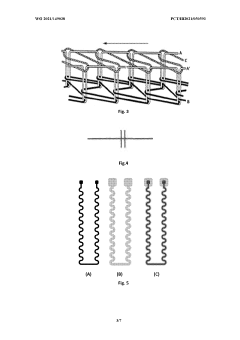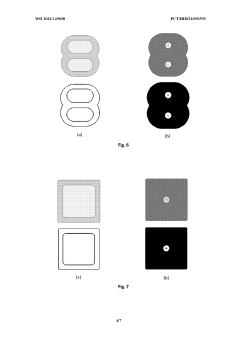Research on smart textile sensors in sports performance monitoring
SEP 29, 20259 MIN READ
Generate Your Research Report Instantly with AI Agent
Patsnap Eureka helps you evaluate technical feasibility & market potential.
Smart Textile Sensor Evolution and Objectives
Smart textile sensors have evolved significantly over the past two decades, transforming from basic conductive fabrics to sophisticated sensing platforms capable of monitoring multiple physiological and biomechanical parameters simultaneously. The journey began in the early 2000s with rudimentary implementations of conductive yarns and simple pressure sensors, primarily used in military applications and medical monitoring. By 2010, these technologies had advanced to incorporate more sophisticated sensing mechanisms, including strain gauges, temperature sensors, and basic moisture detection capabilities.
The evolution accelerated dramatically between 2015 and 2020, with the integration of miniaturized electronics, wireless communication protocols, and energy harvesting technologies. This period saw the emergence of truly wearable smart textile systems capable of continuous monitoring without significantly compromising comfort or mobility. Recent developments have focused on improving sensor durability, washability, and power efficiency—critical factors for adoption in sports performance monitoring.
Current technological trends point toward multi-modal sensing fabrics that can simultaneously track motion dynamics, muscle activity, hydration levels, and thermoregulation. These advancements are being driven by innovations in materials science, particularly in the development of conductive polymers, carbon-based nanomaterials, and textile-compatible microelectronics. The convergence of these technologies is enabling unprecedented levels of integration between the textile substrate and sensing elements.
The primary objective of smart textile sensor research in sports performance monitoring is to develop unobtrusive, reliable, and accurate sensing platforms that can provide real-time, actionable insights to athletes and coaches. These systems aim to enhance training efficiency, prevent injuries, and optimize performance through continuous monitoring of key physiological and biomechanical parameters. Secondary objectives include extending battery life, improving data processing capabilities at the edge, and developing machine learning algorithms specifically tailored to textile-based sensor data.
Looking forward, the field is moving toward creating truly autonomous smart textile systems with self-powering capabilities, self-calibration features, and advanced on-board analytics. The ultimate goal is to develop "second skin" sensing platforms that athletes can wear throughout training and competition without any awareness of the technology, while still benefiting from the wealth of data and insights it provides. This vision requires overcoming significant challenges in materials durability, power management, and signal processing, but represents the next frontier in sports performance monitoring technology.
The evolution accelerated dramatically between 2015 and 2020, with the integration of miniaturized electronics, wireless communication protocols, and energy harvesting technologies. This period saw the emergence of truly wearable smart textile systems capable of continuous monitoring without significantly compromising comfort or mobility. Recent developments have focused on improving sensor durability, washability, and power efficiency—critical factors for adoption in sports performance monitoring.
Current technological trends point toward multi-modal sensing fabrics that can simultaneously track motion dynamics, muscle activity, hydration levels, and thermoregulation. These advancements are being driven by innovations in materials science, particularly in the development of conductive polymers, carbon-based nanomaterials, and textile-compatible microelectronics. The convergence of these technologies is enabling unprecedented levels of integration between the textile substrate and sensing elements.
The primary objective of smart textile sensor research in sports performance monitoring is to develop unobtrusive, reliable, and accurate sensing platforms that can provide real-time, actionable insights to athletes and coaches. These systems aim to enhance training efficiency, prevent injuries, and optimize performance through continuous monitoring of key physiological and biomechanical parameters. Secondary objectives include extending battery life, improving data processing capabilities at the edge, and developing machine learning algorithms specifically tailored to textile-based sensor data.
Looking forward, the field is moving toward creating truly autonomous smart textile systems with self-powering capabilities, self-calibration features, and advanced on-board analytics. The ultimate goal is to develop "second skin" sensing platforms that athletes can wear throughout training and competition without any awareness of the technology, while still benefiting from the wealth of data and insights it provides. This vision requires overcoming significant challenges in materials durability, power management, and signal processing, but represents the next frontier in sports performance monitoring technology.
Sports Performance Monitoring Market Analysis
The global sports performance monitoring market has witnessed substantial growth in recent years, driven by increasing health consciousness and the rising popularity of fitness activities. The market size for sports performance monitoring technologies reached approximately $3.7 billion in 2022 and is projected to grow at a CAGR of 9.8% through 2028, potentially reaching $6.5 billion by the end of the forecast period.
Smart textile sensors represent a rapidly expanding segment within this market, currently accounting for about 18% of the total sports performance monitoring market. This segment is experiencing faster growth than traditional wearable devices due to the superior comfort and seamless integration capabilities that textile-based solutions offer.
Consumer demand patterns indicate a strong preference for non-intrusive monitoring solutions that can provide comprehensive physiological data without impeding athletic performance. Professional sports teams and elite athletes constitute the primary early adopters, with a willingness to invest in premium solutions that offer competitive advantages through data-driven training optimization.
The recreational athlete segment represents the largest market by volume, with increasing adoption rates as technologies become more affordable and user-friendly. This demographic typically seeks solutions that balance functionality with cost-effectiveness, creating significant opportunities for mid-range smart textile products.
Regional analysis reveals North America as the dominant market for sports performance monitoring technologies, holding approximately 42% of the global market share. Europe follows at 28%, with Asia-Pacific emerging as the fastest-growing region with a projected CAGR of 12.3% through 2028, primarily driven by increasing disposable incomes and growing fitness awareness in countries like China, Japan, and South Korea.
Market segmentation by sport type shows that running, cycling, and team sports collectively account for over 65% of smart textile sensor applications. The running segment leads with approximately 28% market share, followed by cycling at 22% and team sports at 15%.
Key market drivers include increasing health consciousness among consumers, growing adoption of preventive healthcare approaches, rising participation in fitness activities, and technological advancements enabling more accurate and comprehensive monitoring capabilities. The integration of artificial intelligence and machine learning algorithms with smart textile sensors is creating new value propositions by enabling predictive analytics and personalized training recommendations.
Smart textile sensors represent a rapidly expanding segment within this market, currently accounting for about 18% of the total sports performance monitoring market. This segment is experiencing faster growth than traditional wearable devices due to the superior comfort and seamless integration capabilities that textile-based solutions offer.
Consumer demand patterns indicate a strong preference for non-intrusive monitoring solutions that can provide comprehensive physiological data without impeding athletic performance. Professional sports teams and elite athletes constitute the primary early adopters, with a willingness to invest in premium solutions that offer competitive advantages through data-driven training optimization.
The recreational athlete segment represents the largest market by volume, with increasing adoption rates as technologies become more affordable and user-friendly. This demographic typically seeks solutions that balance functionality with cost-effectiveness, creating significant opportunities for mid-range smart textile products.
Regional analysis reveals North America as the dominant market for sports performance monitoring technologies, holding approximately 42% of the global market share. Europe follows at 28%, with Asia-Pacific emerging as the fastest-growing region with a projected CAGR of 12.3% through 2028, primarily driven by increasing disposable incomes and growing fitness awareness in countries like China, Japan, and South Korea.
Market segmentation by sport type shows that running, cycling, and team sports collectively account for over 65% of smart textile sensor applications. The running segment leads with approximately 28% market share, followed by cycling at 22% and team sports at 15%.
Key market drivers include increasing health consciousness among consumers, growing adoption of preventive healthcare approaches, rising participation in fitness activities, and technological advancements enabling more accurate and comprehensive monitoring capabilities. The integration of artificial intelligence and machine learning algorithms with smart textile sensors is creating new value propositions by enabling predictive analytics and personalized training recommendations.
Current Smart Textile Technology Landscape
The smart textile sensor landscape has evolved significantly over the past decade, transforming from rudimentary conductive fabrics to sophisticated sensing platforms capable of monitoring multiple physiological and biomechanical parameters simultaneously. Current smart textile technologies for sports performance monitoring primarily utilize five key sensing mechanisms: resistive, capacitive, piezoelectric, optical, and biochemical sensing elements integrated directly into fabric structures.
Resistive sensors dominate the market due to their relatively simple manufacturing processes and cost-effectiveness. These sensors detect changes in electrical resistance when the textile is stretched or compressed, enabling measurements of respiratory rate, muscle activity, and body movement patterns. Major implementations include strain gauges embedded in compression garments that track muscle activation during training sessions.
Capacitive sensing technologies have gained prominence for their ability to detect proximity and pressure without direct contact. These sensors excel in monitoring subtle movements and can function effectively even when separated from the skin by layers of clothing, making them particularly valuable for cold-weather sports applications where multiple clothing layers are necessary.
Piezoelectric textile sensors represent the cutting edge of current technology, converting mechanical stress into electrical signals without requiring external power sources. This self-powering capability makes them ideal for long-duration athletic monitoring. Recent advancements have improved their washability and durability, addressing previous limitations that restricted commercial adoption.
Optical fiber integration into textiles has created new possibilities for monitoring blood oxygen levels, heart rate, and muscle oxygenation through photoplethysmography techniques. These systems utilize light-emitting and light-detecting components woven directly into fabrics, though they currently face challenges related to motion artifacts during high-intensity activities.
Biochemical sensing textiles capable of analyzing sweat composition represent the newest frontier, with emerging capabilities to monitor electrolyte balance, hydration status, and metabolic markers in real-time. While promising, these technologies still face significant hurdles regarding sensor stability and calibration over extended use periods.
Manufacturing processes have evolved to accommodate these advanced sensing capabilities, with techniques such as screen printing of conductive inks, direct fiber coating, and knitting with functional yarns becoming standardized. Interconnection technologies have similarly advanced, with flexible printed circuit boards and conductive adhesives replacing traditional rigid connections.
Power management remains a critical challenge, with current solutions ranging from flexible batteries and supercapacitors to energy harvesting systems that capture energy from body heat or movement. Data transmission typically relies on Bluetooth Low Energy protocols, though newer systems are beginning to incorporate ultra-wideband and near-field communication technologies for improved data transfer rates and reduced power consumption.
Resistive sensors dominate the market due to their relatively simple manufacturing processes and cost-effectiveness. These sensors detect changes in electrical resistance when the textile is stretched or compressed, enabling measurements of respiratory rate, muscle activity, and body movement patterns. Major implementations include strain gauges embedded in compression garments that track muscle activation during training sessions.
Capacitive sensing technologies have gained prominence for their ability to detect proximity and pressure without direct contact. These sensors excel in monitoring subtle movements and can function effectively even when separated from the skin by layers of clothing, making them particularly valuable for cold-weather sports applications where multiple clothing layers are necessary.
Piezoelectric textile sensors represent the cutting edge of current technology, converting mechanical stress into electrical signals without requiring external power sources. This self-powering capability makes them ideal for long-duration athletic monitoring. Recent advancements have improved their washability and durability, addressing previous limitations that restricted commercial adoption.
Optical fiber integration into textiles has created new possibilities for monitoring blood oxygen levels, heart rate, and muscle oxygenation through photoplethysmography techniques. These systems utilize light-emitting and light-detecting components woven directly into fabrics, though they currently face challenges related to motion artifacts during high-intensity activities.
Biochemical sensing textiles capable of analyzing sweat composition represent the newest frontier, with emerging capabilities to monitor electrolyte balance, hydration status, and metabolic markers in real-time. While promising, these technologies still face significant hurdles regarding sensor stability and calibration over extended use periods.
Manufacturing processes have evolved to accommodate these advanced sensing capabilities, with techniques such as screen printing of conductive inks, direct fiber coating, and knitting with functional yarns becoming standardized. Interconnection technologies have similarly advanced, with flexible printed circuit boards and conductive adhesives replacing traditional rigid connections.
Power management remains a critical challenge, with current solutions ranging from flexible batteries and supercapacitors to energy harvesting systems that capture energy from body heat or movement. Data transmission typically relies on Bluetooth Low Energy protocols, though newer systems are beginning to incorporate ultra-wideband and near-field communication technologies for improved data transfer rates and reduced power consumption.
Existing Smart Textile Solutions for Athletes
01 Wearable health monitoring textile sensors
Smart textile sensors integrated into clothing for continuous health monitoring. These sensors can track vital signs such as heart rate, body temperature, respiration, and other physiological parameters. The textiles incorporate conductive fibers and flexible electronics that maintain comfort while providing accurate health data monitoring for medical applications and fitness tracking.- Wearable health monitoring textile sensors: Smart textile sensors integrated into clothing for continuous health monitoring. These sensors can track vital signs such as heart rate, respiration, body temperature, and other physiological parameters. The technology enables non-invasive monitoring through conductive fibers and embedded electronics that can transmit data to connected devices for analysis and health assessment.
- Conductive fiber and material technologies: Advanced materials and manufacturing techniques for creating conductive textiles that function as sensors. These include specialized fibers with embedded conductive elements, coatings, or treatments that enable electrical conductivity while maintaining textile properties like flexibility and comfort. The materials can detect changes in pressure, strain, temperature, or other environmental factors while being washable and durable for everyday use.
- Smart textile sensor networks and connectivity: Systems for integrating multiple textile sensors into networks within garments, enabling comprehensive data collection and transmission. These networks incorporate wireless communication technologies to transmit sensor data to smartphones, computers, or cloud platforms. The connectivity solutions include power management systems, data processing units, and protocols designed specifically for textile-integrated electronics.
- Motion and gesture detection textile interfaces: Textile sensors designed to detect and interpret human movements, gestures, and interactions. These sensors can be integrated into clothing or accessories to create intuitive interfaces for controlling electronic devices, gaming, virtual reality applications, or assistive technologies. The technology enables the recognition of specific movements or touch patterns on the textile surface to trigger programmed responses.
- Environmental and structural monitoring textiles: Smart textile sensors designed to monitor environmental conditions or structural integrity. These textiles can detect temperature changes, humidity, presence of specific chemicals, UV radiation, or mechanical stress in structures. Applications include protective clothing that warns of hazardous conditions, architectural textiles that monitor building integrity, or environmental monitoring systems integrated into fabrics.
02 Pressure and motion sensing textiles
Textile sensors designed to detect pressure, strain, and motion for various applications. These smart fabrics use conductive materials and piezoelectric elements woven into the textile structure to detect physical interactions. Applications include sports performance analysis, rehabilitation monitoring, gesture recognition interfaces, and posture assessment systems.Expand Specific Solutions03 Environmental and chemical sensing fabrics
Smart textiles that can detect environmental conditions and chemical substances. These fabrics incorporate specialized sensing elements that can monitor temperature, humidity, UV exposure, and detect the presence of specific chemicals or gases. Applications include protective clothing for workers in hazardous environments, military applications, and environmental monitoring.Expand Specific Solutions04 Manufacturing methods for smart textile sensors
Innovative manufacturing techniques for integrating electronic components and sensing elements into textiles. These methods include conductive ink printing, embroidery with conductive threads, weaving or knitting with specialized fibers, and lamination processes. The manufacturing approaches focus on creating durable, washable, and comfortable smart textiles while maintaining sensing functionality.Expand Specific Solutions05 Power management and connectivity for textile sensors
Systems for powering smart textile sensors and transmitting data from these wearable devices. These solutions include flexible batteries, energy harvesting technologies (such as solar, kinetic, or thermal), wireless communication protocols, and low-power electronics. The focus is on creating self-sufficient textile sensors that can operate for extended periods while maintaining connectivity to data collection systems.Expand Specific Solutions
Leading Companies in Smart Textile Industry
The smart textile sensors market for sports performance monitoring is currently in a growth phase, characterized by increasing adoption across professional and consumer segments. The market size is expanding rapidly, driven by the rising demand for real-time biometric data in sports training and competition. Technologically, the field is advancing from basic motion tracking to sophisticated biometric monitoring, with companies at varying maturity levels. Industry leaders like NIKE and ADIDAS are leveraging their brand power to integrate smart textiles into mainstream products, while specialized players such as Nanowear, Myant, and Plux are developing cutting-edge nanosensor technologies. Academic institutions including University of Maryland and Hong Kong Polytechnic University are contributing significant research innovations, creating a competitive ecosystem where commercial applications are increasingly sophisticated and diverse.
NIKE, Inc.
Technical Solution: Nike has developed advanced smart textile sensors integrated into their Nike Pro Elite line for sports performance monitoring. Their technology utilizes conductive yarns and fabrics with embedded microsensors that can track multiple biometric parameters simultaneously. Nike's NikeConnect technology incorporates NFC chips into performance apparel that sync with mobile applications to provide real-time data on muscle activation, heart rate, body temperature, and movement patterns. Their proprietary algorithms analyze this data to provide actionable insights for athletes. Nike has also pioneered moisture-wicking fabrics with integrated strain sensors that maintain accuracy even during intense sweating, solving a common problem in sports monitoring textiles. Their recent innovations include textile-based pressure mapping systems that analyze foot strike patterns and running gait mechanics with precision comparable to laboratory equipment.
Strengths: Seamless integration of sensors into aesthetically appealing sportswear without compromising comfort or performance; extensive distribution network and brand recognition accelerating market adoption. Weaknesses: Higher price point compared to competitors; proprietary ecosystem limits compatibility with third-party analytics platforms.
Plux - Wireless Biosignals SA
Technical Solution: Plux has developed the BioSleeve platform, an advanced smart textile solution specifically designed for sports performance monitoring. Their technology integrates multiple sensing modalities into compression garments, focusing on high-precision electromyography (EMG) and motion analysis. Plux's innovation lies in their development of textile-based dry electrodes that maintain signal quality comparable to medical-grade gel electrodes even during intense physical activity. Their garments incorporate a distributed network of sensors connected by conductive pathways woven directly into the fabric structure, eliminating the need for traditional wiring. Plux has pioneered advanced signal processing algorithms that can isolate muscle activation patterns from motion artifacts, solving a major challenge in dynamic sports monitoring. Their BioSleeve platform provides real-time feedback on muscle recruitment patterns, movement efficiency, and technique optimization through a companion mobile application. The company has also developed specialized textile sensors for specific sports applications, including golf swing analysis, running gait optimization, and swimming stroke mechanics.
Strengths: Superior signal processing capabilities that effectively filter motion artifacts; specialized sport-specific applications provide highly relevant data for targeted performance improvement. Weaknesses: More focused on upper-body monitoring with less comprehensive full-body solutions; higher technical complexity requires more user training for optimal benefit.
Key Patents in Smart Textile Sensing Technology
Smart textiles suitable for detecting movement and/or deformation
PatentActiveJP2022509028A
Innovation
- A stretchable conductive fabric with electrodes and a neural network inference engine to detect movements by applying Electrical Impedance Tomography (EIT) principles, using a neural network to predict joint angles with high accuracy.
Sensorized garment or clothing item, method of operation and uses thereof
PatentWO2021149038A1
Innovation
- A sensorized extensible textile suit integrating conductive threads, electrocardiography, electromyography, and elasticity sensors, along with a data processor and communication module, allowing for remote monitoring and data analysis through a mobile application, ensuring precise and sustainable performance evaluation without the need for disposable sensors.
Durability and Washability Challenges
Smart textile sensors in sports performance monitoring face significant durability and washability challenges that must be addressed for widespread adoption. These sensors, integrated into athletic apparel, are subjected to extreme mechanical stresses during sports activities, including stretching, compression, and abrasion. Research indicates that repeated mechanical deformation can lead to sensor degradation, with performance typically declining after 50-100 wear cycles depending on sensor type and integration method.
Water exposure presents another critical challenge, as most athletes expect their performance apparel to withstand regular washing. Traditional electronic components are inherently vulnerable to moisture, creating a fundamental design conflict. Studies from leading textile research institutes show that approximately 60% of first-generation smart textile sensors experience significant performance degradation after just 5-10 washing cycles, making them impractical for regular use.
The integration methods between electronic components and textile substrates represent a key vulnerability point. Current approaches include conductive thread stitching, direct printing of conductive inks, and lamination techniques. Each method presents unique durability profiles, with laminated sensors showing better initial water resistance but poorer mechanical durability compared to stitched implementations. Recent innovations in encapsulation materials have improved washability, with hydrophobic nano-coatings extending functional washing cycles to 20-30 for advanced prototypes.
Temperature fluctuations during washing cycles (particularly hot water washing and machine drying) accelerate degradation of sensor components. Research from sports technology laboratories demonstrates that thermal cycling between 20°C and 60°C—typical in washing machines—can reduce sensor lifespan by up to 40% compared to controlled temperature environments. This thermal stress particularly affects polymer-based conductive materials commonly used in flexible sensors.
Chemical exposure from detergents introduces additional complications, as surfactants and enzymes in washing agents can degrade conductive materials and adhesives. Studies show pH variations in detergents significantly impact sensor conductivity, with alkaline detergents (pH > 8) causing more rapid degradation than neutral formulations. Industry testing protocols now recommend specialized low-impact cleaning regimens for smart textiles, though these often conflict with consumer expectations of maintenance simplicity.
Recent advances in materials science offer promising solutions, including self-healing conductive polymers and improved encapsulation techniques. These innovations have extended the functional lifespan of some experimental smart textile sensors to over 50 washing cycles while maintaining 90% of initial performance metrics—a significant improvement but still short of the 100+ cycles expected from premium athletic apparel.
Water exposure presents another critical challenge, as most athletes expect their performance apparel to withstand regular washing. Traditional electronic components are inherently vulnerable to moisture, creating a fundamental design conflict. Studies from leading textile research institutes show that approximately 60% of first-generation smart textile sensors experience significant performance degradation after just 5-10 washing cycles, making them impractical for regular use.
The integration methods between electronic components and textile substrates represent a key vulnerability point. Current approaches include conductive thread stitching, direct printing of conductive inks, and lamination techniques. Each method presents unique durability profiles, with laminated sensors showing better initial water resistance but poorer mechanical durability compared to stitched implementations. Recent innovations in encapsulation materials have improved washability, with hydrophobic nano-coatings extending functional washing cycles to 20-30 for advanced prototypes.
Temperature fluctuations during washing cycles (particularly hot water washing and machine drying) accelerate degradation of sensor components. Research from sports technology laboratories demonstrates that thermal cycling between 20°C and 60°C—typical in washing machines—can reduce sensor lifespan by up to 40% compared to controlled temperature environments. This thermal stress particularly affects polymer-based conductive materials commonly used in flexible sensors.
Chemical exposure from detergents introduces additional complications, as surfactants and enzymes in washing agents can degrade conductive materials and adhesives. Studies show pH variations in detergents significantly impact sensor conductivity, with alkaline detergents (pH > 8) causing more rapid degradation than neutral formulations. Industry testing protocols now recommend specialized low-impact cleaning regimens for smart textiles, though these often conflict with consumer expectations of maintenance simplicity.
Recent advances in materials science offer promising solutions, including self-healing conductive polymers and improved encapsulation techniques. These innovations have extended the functional lifespan of some experimental smart textile sensors to over 50 washing cycles while maintaining 90% of initial performance metrics—a significant improvement but still short of the 100+ cycles expected from premium athletic apparel.
Data Privacy in Wearable Sports Technology
As the integration of smart textile sensors in sports performance monitoring continues to advance, data privacy concerns have emerged as a critical consideration. The collection of biometric data through wearable sports technology creates significant privacy implications that must be addressed. Athletes' physiological metrics, movement patterns, and location data represent highly sensitive personal information that requires robust protection frameworks.
Current privacy regulations such as GDPR in Europe and CCPA in California have established baseline requirements for data handling, but the specialized nature of athletic performance data presents unique challenges. Smart textile sensors can collect continuous streams of intimate biometric information including heart rate variability, respiration patterns, muscle activation, and even sweat composition - all of which may reveal sensitive health conditions beyond mere performance metrics.
The ownership of collected data remains a contentious issue in the wearable sports technology ecosystem. Athletes, teams, equipment manufacturers, and analytics providers all maintain legitimate interests in the data, creating complex questions of consent and control. Professional athletes particularly face concerns about how their performance data might be used in contract negotiations or shared with competing organizations.
Data security vulnerabilities present another significant challenge. Wireless transmission protocols commonly used in smart textile systems may be susceptible to interception, while cloud storage of aggregated performance data creates potential targets for breaches. The consequences of compromised athletic performance data extend beyond privacy violations to potential competitive disadvantages if training methodologies or physiological weaknesses are exposed.
Emerging best practices include implementing privacy-by-design principles in smart textile sensor development, utilizing differential privacy techniques to anonymize data while maintaining analytical value, and establishing clear data governance frameworks that specify retention periods and usage limitations. Some manufacturers have introduced local processing capabilities that minimize data transmission requirements, allowing sensitive calculations to occur on the device rather than in the cloud.
The future of data privacy in wearable sports technology will likely involve more granular consent mechanisms, allowing athletes to maintain precise control over which metrics are collected and how they're utilized. Blockchain-based solutions are being explored to create immutable records of data access and usage, while federated learning approaches may enable performance insights without centralizing sensitive data. As smart textile sensors become increasingly sophisticated, the privacy frameworks governing their use must evolve in parallel.
Current privacy regulations such as GDPR in Europe and CCPA in California have established baseline requirements for data handling, but the specialized nature of athletic performance data presents unique challenges. Smart textile sensors can collect continuous streams of intimate biometric information including heart rate variability, respiration patterns, muscle activation, and even sweat composition - all of which may reveal sensitive health conditions beyond mere performance metrics.
The ownership of collected data remains a contentious issue in the wearable sports technology ecosystem. Athletes, teams, equipment manufacturers, and analytics providers all maintain legitimate interests in the data, creating complex questions of consent and control. Professional athletes particularly face concerns about how their performance data might be used in contract negotiations or shared with competing organizations.
Data security vulnerabilities present another significant challenge. Wireless transmission protocols commonly used in smart textile systems may be susceptible to interception, while cloud storage of aggregated performance data creates potential targets for breaches. The consequences of compromised athletic performance data extend beyond privacy violations to potential competitive disadvantages if training methodologies or physiological weaknesses are exposed.
Emerging best practices include implementing privacy-by-design principles in smart textile sensor development, utilizing differential privacy techniques to anonymize data while maintaining analytical value, and establishing clear data governance frameworks that specify retention periods and usage limitations. Some manufacturers have introduced local processing capabilities that minimize data transmission requirements, allowing sensitive calculations to occur on the device rather than in the cloud.
The future of data privacy in wearable sports technology will likely involve more granular consent mechanisms, allowing athletes to maintain precise control over which metrics are collected and how they're utilized. Blockchain-based solutions are being explored to create immutable records of data access and usage, while federated learning approaches may enable performance insights without centralizing sensitive data. As smart textile sensors become increasingly sophisticated, the privacy frameworks governing their use must evolve in parallel.
Unlock deeper insights with Patsnap Eureka Quick Research — get a full tech report to explore trends and direct your research. Try now!
Generate Your Research Report Instantly with AI Agent
Supercharge your innovation with Patsnap Eureka AI Agent Platform!
